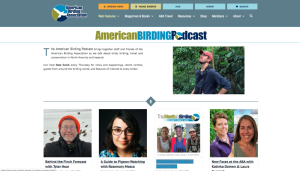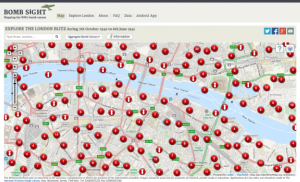Theme: Geographic Information Systems (GIS)
Back to Top
|
 |
|
Esri: GeoInquiries
|
Science |
|
Teachers of a variety of subjects and grade levels who would like to incorporate maps into their classroom activities may want to check out Esri's GeoInquiries, a collection of short, standards-based inquiry activities for teaching map-based content found in commonly used textbooks. Here, visitors will find a library of activities organized by topic, with each topic containing 15-20 different activities. For example, the American Literature section offers activities to enhance students' understanding of books such as The Great Gatsby and Into the Wild, while the Mathematics section offers a range of geometry and beginning algebra activities. GeoInquiries also covers topics such as Earth Science, Government, and World Geography. Each GeoInquiry activity includes a teachers' guide in PDF format, an interactive webmap, and an optional worksheet for students. Most activities are Level 1, which are "activities that teach standards-based content without a login to or installation of ArcGIS Online." Some topics also offer Level 2 activities that use ArcGIS Online analysis tools. Those new to using GeoInquiries should be sure to read through the guide Getting to Know GeoInquiries, which is linked in the introductory paragraph on the collection's main page. [JDC] |
|





|
|
 |
|
Directions Magazine
|
Science |
|
Interested in keeping up with trends in the GIS and geospatial technology industry? Then Directions Magazine may be just the ticket. This site was co-founded by Jane Elliott and her late husband Scott Elliott in 1998 "as the first entirely online geospatial publication." Here, visitors will find an array of articles, interviews, webinars (free, but may require registration), podcast episodes, and more. These resources explore a wide range of current geospatially-related topics, such as the complexities of using geospatial technology to map cultural resources and how an Austrian surveying company successfully dealt with the challenge of capturing high-precision data over a large expanse of the Alps. Menus at the top allow visitors to view content by topic or by type, and the site is searchable as well. Some of the magazine's content was published as multi-part series, which have been grouped together as Playlists. While Directions Magazine is intended primarily for GIS and geospatial professionals and educators, much of its content is largely approachable for non-experts as well. In addition to its own content, Directions Magazine also has a sizable list of publicly accessible online Data Resources. [JDC] |
|





|
|
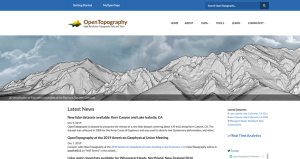 |
|
Open Topography
|
Science |
|
OpenTopography provides high-quality geographic data relating to earth science as well as a platform for researchers to share their own data. Based at the University of California, San Diego, OpenTopography is an ambitious project that "facilitates community access to high-resolution, Earth science-oriented, topography data, and related tools and resources," and is funded through the National Science Foundation. Visitors can search or browse the project's more than 300 datasets (as of this write-up) via an interactive data map and a data catalog, both found under Data. Most of these datasets are available in Lidar point cloud format, and many are also available in other formats, such as raster or Google Earth. Visitors should also check out the Tools section, where they will find descriptions of the tools OpenTopography uses to enable on-demand processing, analysis, and visualization of their datasets. This section also contains their Tool Registry, which they describe as "a community populated clearinghouse of software, utilities, and tools oriented towards high-resolution topography data," as well as OpenTopography's open-source software. For new users, the Getting Started page (linked at the upper left) provides a helpful orientation to the site, and there are also several tutorials on Lidar available under Learn. [JDC] |
|





|
|
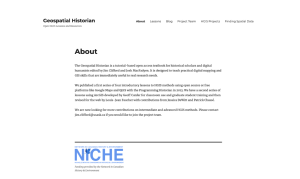 |
|
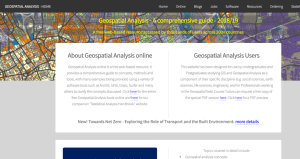 |
|
Geospatial Analysis Online
|
Science |
|
For anyone who needs to learn, review, or teach the concepts and methodologies of GIS analysis, Geospatial Analysis Online is a welcome boon. This resource is a free web-based version of the textbook Geospatial Analysis: A Comprehensive Guide, written by Michael de Smith and Paul Longley of the University College London and by Michael Goodchild of the University of California-Santa Barbara. As of this write-up, visitors to the above link will find the sixth edition of this handbook (published in 2018), which "address[es] the full spectrum of spatial analysis and associated modeling techniques that are provided within currently available and widely used geographic information systems (GIS) and associated software." Some of the topics covered in the book's 10 chapters include an overview of the conceptual frameworks used in spatial analysis, the core components of GIS analysis, discussions of spatial statistics and surface and field analysis, as well as big data as it relates to spatial analysis. This comprehensive guide can be read online in its entirety at the link above. Those interested in purchasing a physical or PDF e-book copy can find links to do so under Ordering. Other noteworthy portions of the Geospatial Analysis Online website include links to GIS-related Blogs, Software, and other Resources. [JDC] |
|





|
|





